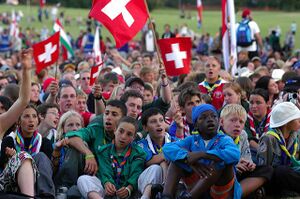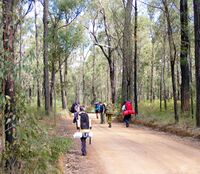Scout
- For girl troops see: Girl Guide and Girl Scout.
A Scout (in some countries a Boy Scout) is usually between 11 to 18 years of age. Because of the large age and [development span, many Scouting associations have split this age group in a junior and a senior section. Scouts are organized into troops averaging twenty to thirty Scouts under guidance of one or more Scout Leaders. Troops subdivide into patrols of about six Scouts and engage in outdoor and special interest activities. Troops may affiliate with local, national, and international organizations. Some national Scouting associations have special interest programs such as Air Scouts, Sea Scouts, outdoor high adventure, Scouting bands, and rider scouts. Some troops, especially in Europe, have been co-educational since the 1970s, allowing boys and girls to work together as Scouts.
Foundation
Robert Baden-Powell founded the Boy Scouts as an organization in 1908, a few months after the first scout encampment at Brownsea Island Scout camp in 1907.[1] Baden-Powell got the idea from his experiences with the British Army in South Africa. To advance his ideas, Baden-Powell wrote Scouting for Boys for boy readership, which describes the Scout method of outdoor activities aiming at developing character, citizenship, and personal fitness qualities among youth.[2] Many boys joined Scouting activities, resulting in the movement growing rapidly to become the world's largest youth organization.
The Scout program is designed to develop youths who have a high degree of self-reliance, initiative, courage, helpfulness, integrity, and resourcefulness. Scouts should be helpful; understand their society, heritage, and culture; have respect for the rights of others; and be positive leader-citizens.[3][4]
Over time, the Scout program has been reviewed and updated in many of the countries where it is run, and special interest programs developed such as Air Scouts, Sea Scouts, outdoor high adventure, Scouting bands, and rider scouts, but the same core values and principles as Baden-Powell originally envisaged still apply.
Age groups and sections
Originally, the Scout program was aimed at 11- to 16-year-old boys. However, the younger brothers of Boy Scouts started to attend Troop meetings, and so the Cub Scout section was started. It was also evident that young girls wanted to participate in similar activities, but the Edwardian values at the time would not allow young boys and girls to "rough and tumble" together, causing the Guide Movement to be created.
While most Scouts may join a troop after finishing Cub Scouts, this is not required. As Scouts get older, they often seek more challenging and diverse activities. He may later join another affiliated program for older boys and girls, such as Exploring, Venturing, or Rovering.
Activities
A Scout learns the cornerstones of the Scout method, Scout Promise, and Scout Law. These are designed to instill character, citizenship, personal fitness, and leadership in boys through a structured program of outdoor activities.[5][6] Common ways to implement the Scout method include spending time together in small groups with shared experiences, rituals, and activities, as well as emphasizing good citizenship and decision-making that are age-level appropriate. Cultivating a love and appreciation of the outdoors and outdoor activities are key elements. Primary activities include camping, woodcraft, first aid, aquatics, hiking, backpacking, and sports.
Scouts are known throughout the world for performing acts of public good and sometimes acts of heroism. For example, a boy Scout foiled a 2008 assassination attempt on Maldives' President Maumoon Abdul Gayoom by "grabbing an attacker's knife as the man leapt from a crowd and lunged at the leader."[7] The scout, Ibrahim Jaisham, a male member of the co-educational The Scout Association of Maldives, sustained minor injuries during the intervention and was subsequently treated.[8][9]
Fellowship
Camping most often occurs on a unit level, such as in the troop, but there are periodic camporees and jamborees. Camporees are events where units from a local area camp together for a weekend. These occur a couple times a year and usually have a theme, such as pioneering. Jamborees are large events on a national or international level held every four years where thousands of Scouts camp together for one to two weeks. Activities at these events include games, scoutcraft competitions, patch trading, aquatics, woodcarving, archery, and rifle and shotgun shooting.
For many Scouts and Scouters, the highlight of the year is spending at least a week in the summer as part of an outdoor activity. This can be a long event such as camping, hiking, sailing, canoeing, or kayaking with the unit or a summer camp operated on a council, state, or provincial level. Scouts attending a summer camp, generally one week during the summer, work on merit badges, advancement, and perfecting scoutcraft skills. Some summer camps operate specialty programs, such as sailing, backpacking, canoeing and whitewater, caving, and fishing.
Personal progression
A large part, compared to younger and older sections, of the activities are related to personal progression. All Scouting organizations have an advancement program, whereby the Scout learns scoutcraft, community service, leadership, and explores areas of interest to him. This Badge system or Personal Progressive Scheme is based on two complementary elements:
- Proficiency (Merit) badges, which are intended to encourage the Scout to learn a subject which could be his work or hobby, so cover many different types of activities, not always related to Scouting.
- Class badges or Progress system, which symbolize increasingly difficult levels or successive stages.
Most Scouting associations have a highest badge that require mastering scoutcraft, leadership, and performing community service. Only a small percentage of Scouts attain them.
Unit affiliation
Troop
The troop is the fundamental unit of the Scouts. This is the group a Scout joins and via which he participates in Scouting activities, such as camping, backpacking, and canoeing. The troop leadership, youth and adult, organizes and provides support for these activities. It may include as few as a half-dozen Scouts, or as many as seventy or more. Troops usually meet weekly.
Patrol
Each troop is divided into patrols of six to ten Scouts and use the patrol method, where the Scouts divide into smaller groups within the troop. A patrol's independence from the troop varies among troops and between activities. For instance, a troop typically holds ordinary meetings as a unit. Patrols' autonomy becomes more visible at campouts, where each patrol may set up its own cooking area. However, on a high adventure trip which only a small part of the troop attends, divisions between patrols may disappear entirely. Patrols may hold meetings and even excursions separately from the rest of the troop, but this is more common in some troops than in others.[10] Each patrol has a Patrol Leader (PL) and Assistant Patrol Leader (APL). Some troops mix older and younger Scouts in the same patrols, so that the older Scouts can teach the younger ones more effectively, other troops group Scouts by age, so that the members of one patrol have more in common.
Group
In most countries a local organisation, a "Scout Group", combines different sections together into a single body. Scout Groups can consist of any number of sections of the different Age Groups in Scouting and Guiding. Scout Groups can be single sex or have boys and girls in separate and/or co-ed sections depending on the group and the national organization. In some countries, the different sections are independent of each other, although they might be sponsored or chartered by the same organisation, such as a church.
Uniforms
The Scout uniform is a specific characteristic of Scouting. The original uniform, which has created a familiar image in the public eye and had a very military appearance, consisted of a khaki button-up shirt, shorts, and a broad-brimmed campaign hat.
Uniforms have become much more functional and colorful since the beginning and are now frequently blue, orange, red, or green, and shorts are replaced by long trousers in areas where the culture calls for modesty, and in winter weather. T-shirts and other more casual wear have also replaced the more formal button-up uniforms in many Scouting regions.
To show the unity of all Scouts, the World Membership Badge (World Crest) or another badge with a fleur-de-lis is a part of all uniforms. Neckerchiefs and Woggles (slides) are still quite common, but some Scouting associations do not use them. Patches for leadership positions, ranks, special achievements, patrol- animals, colors or names, troop- or group- numbers or names, and country or regional affiliation are standard.
See also
References
- ↑ Woolgar, Brian; La Riviere, Sheila (2002). Why Brownsea? The Beginnings of Scouting. Brownsea Island Scout and Guide Management Committee.
- ↑ Boehmer, Elleke (2004). Notes to 2004 edition of Scouting for Boys. Oxford: Oxford University Press.
- ↑ "What is Boy Scouting? Purpose of the BSA". Boy Scouts of America. http://www.scouting.org/Media/FactSheets/02-503.aspx. Retrieved 2006-07-27.
- ↑ "About Our World". The Scout Association. http://www.scouts.org.uk/aboutus/index.htm. Retrieved 2006-07-27.
- ↑ "Constitution of WOSM" (PDF). World Organization of the Scout Movement. April 2000. http://www.scout.org/en/information_events/resource_centre/institutional_documents/constitution_of_w_o_s_m. Retrieved 2006-07-10., p. 2-15
- ↑ "Scouting: An Educational System" (PDF). World Organization of the Scout Movement. 1998. http://www.scout.org/en/information_events/resource_centre/library/the_scout_library/adult_resources_and_management/scouting_an_educational_system. Retrieved 2006-07-10., p. 9
- ↑ "Boy Foils Attempt on Maldives President," by Krishan Francis, AP, 9 Jan 2008. http://news.yahoo.com/s/ap/20080109/ap_on_re_as/maldives_assassination_attempt
- ↑ afp.google.com, Boy Scout saves Maldives president from assassination
- ↑ cnn.com, Boy Scout foils attack on Maldives president
- ↑ "Troop Organization". US Scouts.org. April 2000. http://usscouts.org/boyscouts/bstroop.html. Retrieved 2006-07-26., p. 2-15

